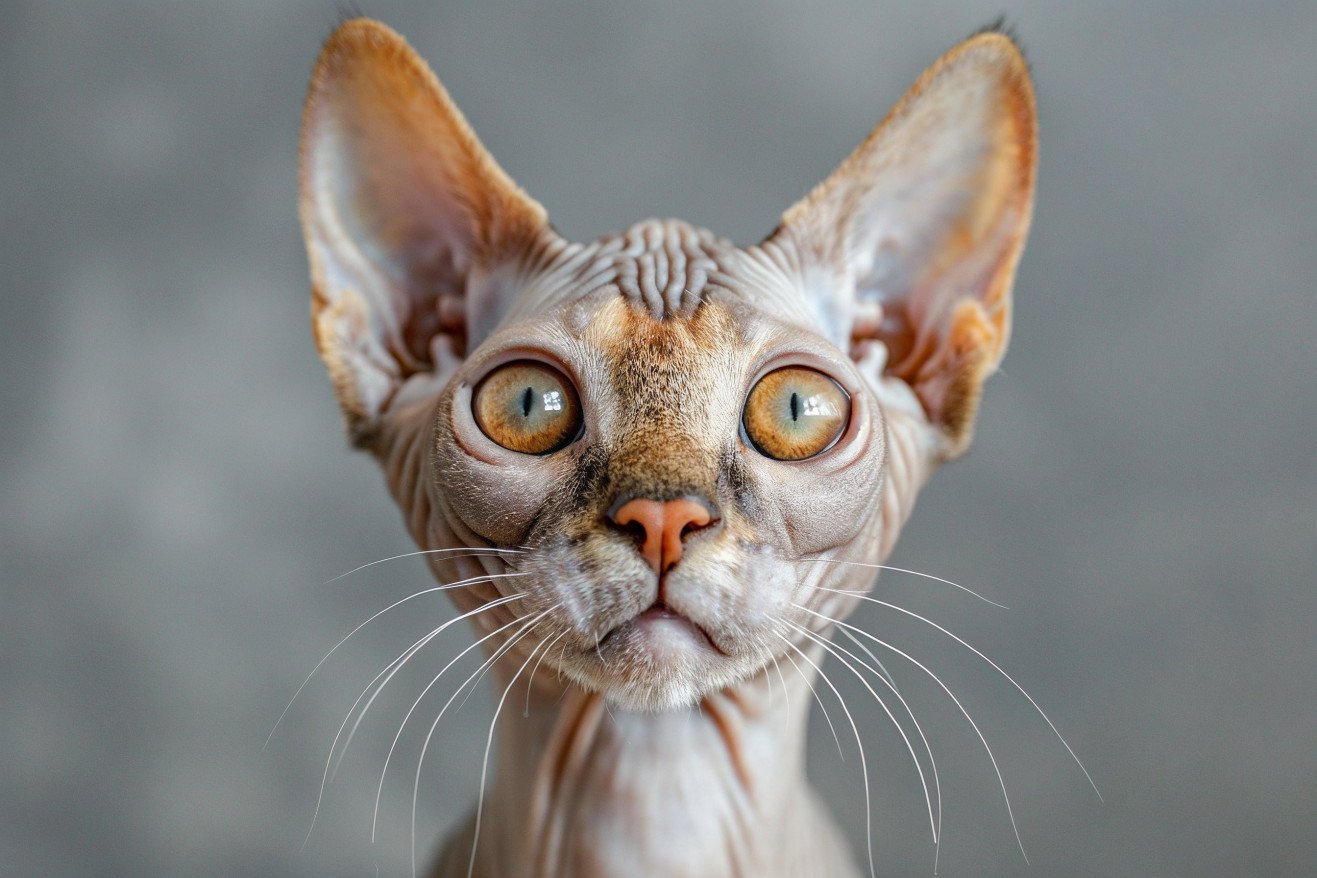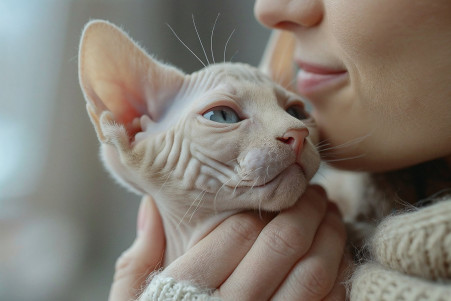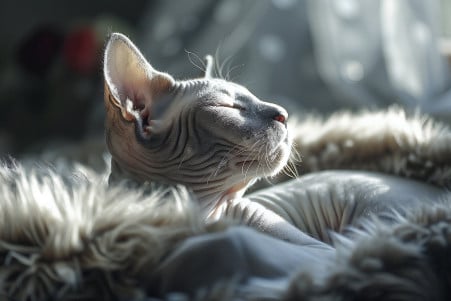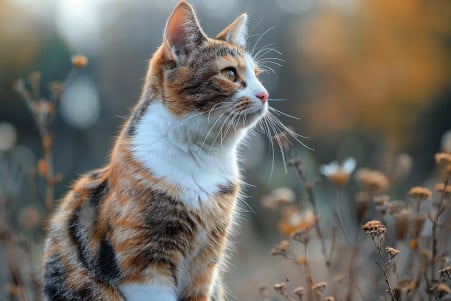The Genetics of Hairless Cats: Unveiling the Science Behind Their Unique Coats
31 May 2024 • Updated 30 May 2024

While the hairless cat is a truly one-of-a-kind animal, you may be wondering about the genetics that make it possible for certain cat breeds to be born without a coat. Hairless cats are hairless due to a genetic mutation that causes a deficiency or abnormality in one of the proteins that are important for normal hair and skin development.
These genetic mutations are natural and have arisen in the cat population, making them an interesting area of research when it comes to understanding hair growth and skin biology in mammals. In this article, we'll cover the most recent veterinary and genetic studies that have helped to uncover the genes and biological processes that are responsible for hairlessness in cats. This will help us understand the mutations better and learn more about the proteins and how they work in the development of hair follicles in cats and other mammals, including humans.
What genetic anomalies are responsible for creating hairless cats?
History and Background of the Sphynx Cat
The Sphynx cat is a hairless breed that arose from a natural genetic mutation. The first hairless kitten, Prune, was born to a domestic shorthair in 1966. This genetic mutation was of interest to cat breeders, who began selectively breeding hairless cats in the 1970s to create a new breed - the Sphynx.
Breeders in Canada and the United States worked with the genetic mutation to create the Sphynx breed, introducing new bloodlines and expanding the gene pool. The Sphynx's unique appearance and friendly personality quickly won over cat fanciers and pet owners.
Sphynx breeders worked to introduce new bloodlines and expand the gene pool, and the breed was soon recognized as a separate breed from the domestic shorthair. The Sphynx's unique appearance and friendly personality made it popular as both a pet and a show cat.
The Sphynx was initially considered a mutation and a novelty, but the breed's unique appearance and friendly personality quickly won over cat fanciers and pet owners. The Sphynx's unique appearance and friendly personality set it apart from other breeds and established it as a new cat breed separate from the domestic shorthair.
Grooming and Care Needs of Hairless Cats
Even though they don't have hair, Sphynx cats need a lot of grooming and skin care to keep them healthy and looking their best. PetMD notes that regular baths, ear cleanings, and nail clippings are necessary to keep oil, infections, and skin issues at bay. Sphynx cats are also sensitive to the sun and temperature and need to be kept indoors and shielded from the elements.
Hairless cats also need to be fed a healthy diet and have their teeth taken care of to ensure they stay healthy. Spot explains that common health problems for Sphynx cats include skin issues, ear infections, and heart disease. It's also important to make sure that they have access to a vet who has experience treating hairless cats, as they may have special needs and health issues.
Skin Conditions and Genetic Disorders in Hairless Cats
Sphynx cats are at risk for a number of health problems due to their hairless state and the genetic mutations that cause hairlessness. Spot explains that these issues include skin conditions like urticaria pigmentosa and seborrhea, temperature regulation problems, ear infections, heart disease like hypertrophic cardiomyopathy, and muscle issues due to hereditary myopathy.
Genetic testing and early intervention are important for the management of these issues. According to WebMD, hypertrophic cardiomyopathy, which is the thickening of the heart muscle, is one of the more serious issues that will need to be closely monitored by a vet. Other hairless cats like the Lykoi may also experience similar health issues due to the genetic mutations that cause their hairlessness, as outlined in a paper in Genes.
It will be important for responsible breeding and research to continue to help improve the health and well-being of hairless cat breeds. With the right care and medical intervention, Catster says that Sphynx cats can live to be between 15 and 20 years old.
Other Hairless and Near-Hairless Cat Breeds
Although the Sphynx is the most famous hairless cat breed, there are several other breeds with different degrees of hairlessness or hypotrichia. The Devon Rex has a curly, wavy coat caused by a mutation in the KRT71 gene that is different from the one that causes hairlessness in Sphynx cats. The Lykoi, also known as the 'Werewolf Cat,' has a unique form of hypotrichia caused by mutations in the Hairless (HR) gene. Meanwhile, the Peterbald and the Ukrainian Levkoy also have different degrees of hairlessness or a very short, fine coat.
These breeds offer the chance for more research into the genetic and biological underpinnings of feline hair development and growth. By investigating the mutations and their impact in these different hairless and near-hairless breeds, researchers can learn more about the function of the KRT71 and HR proteins in mammalian hair follicle biology.
Conclusion: The Impact of Hairless Cat Breeds and Feline Genetics Research
The impact of hairless cat breeds and feline genetics research is likely to be significant. Ongoing studies of the genetics and biology of hairless cat breeds have the potential to contribute to our knowledge of hair follicle development and skin diseases. By investigating the specific genetic mutations and their impacts in different hairless cat breeds, researchers can learn more about the proteins that are important for hair growth in mammals.
It is important for the health and welfare of hairless cat breeds that breeders continue to use responsible breeding practices and genetic screening. It is also important for breeders, veterinarians, and geneticists to work together to meet the unique needs of hairless cat breeds and to expand our understanding of these cats.
As our knowledge of feline genetics and hair biology grows, it is possible that new opportunities will emerge for the treatment or management of hair and skin diseases in cats and people.


